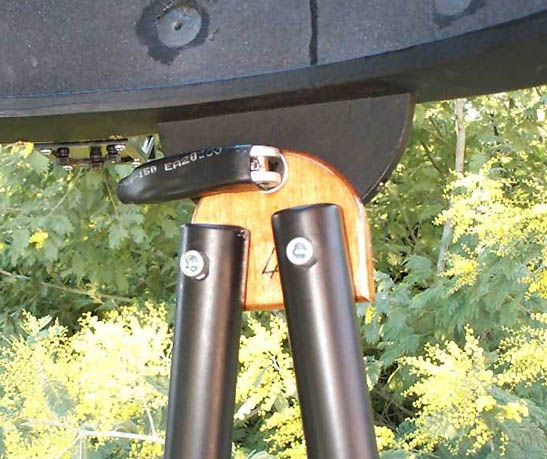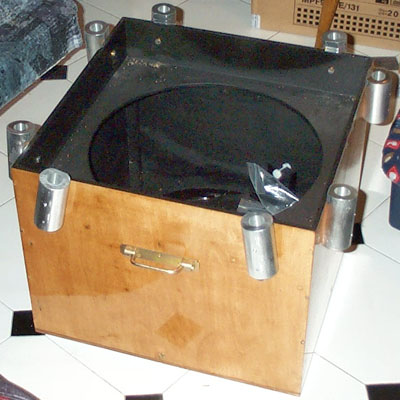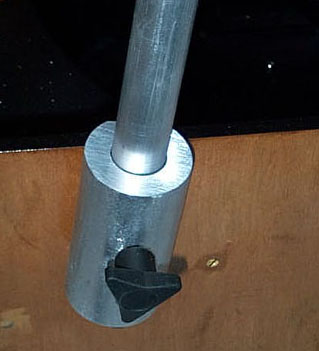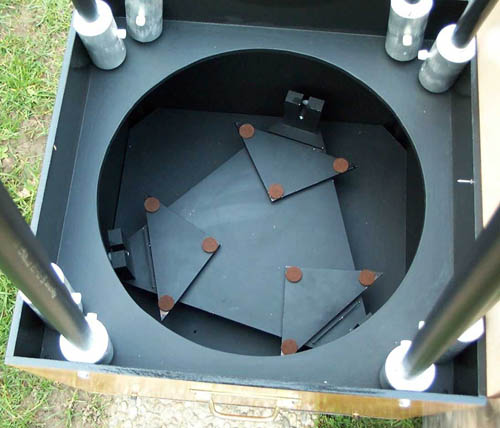Secondary cage and truss tubes
|
|
The rings of the secondary cage are cut from plywood of 12mm thickness whereas the spacers are manufactured from a very light exotic wood of 17mm thickness. Lightweight ultra black foam is then used as a baffle (visible on the right on the photograph). The holes in the spacers make it possible to adjust weight to help facilitate balancing. Dimensions: Internal diameter: 445mm External diameter: 570mm Height: 400mm
|
|
The clamps come from a sporting goods store and are usually used for the wheels of a bicycle. This system is very practical; it allows the installation of the secondary cage without any tools and gives a very solid connection. The tubes, which form there structure are made from aluminum poles that are 25mm in diameter and 1.2mm in thickness. They are filled with polyurethane foam to minimize vibrations and then surrounded by heat-shrinkable sleeves to avoid the stray reflections and to allow the best gripping when the weather is cold. To protect the mirror from stray light, Thierry uses " tubular " black fabric. This fabric is used in the manufacture of skirts without a seam and stretches, primarily in its width. That allows it to fit well and it is available in different widths.
|
|
|
To fix the tubes at the higher part, Thierry manufactured a stage with a fine tube of aluminum; the interior was re-bored so as to avoid any play with the screw BTR. The stage returns in force in the tube aluminum. Fixing is perfect. |
|
|
A punch screw is used to hold the fittings Thierry machined from aluminum and holds the tubes to the mirror box. The eight sleeves must be made identical so that there are no problems while installation the tubes. The mirror box is made from plywood 12mm thick and the cleats are 20mm and reinforce the corners for maximum of rigidity. The links between the plates are made with inserts of copper. Maintaining the tubes as they pass inside the mirror box simplifies the installation of the pivots. Interior dimensions: 400mm X 400mm Height: 405mm
|
|
The mirror cell comes from Astam and is made to be assembled on an equatorial mounting but the price difference having the cell made special for a Dobson is not very significant and allows for any future changes in the instrument. The hole in the center of the cell will allow the installation of a fan to accelerate the cooling of the mirror. The original support pads made out of felt were replaced, they seemed to small.
|
|
One can note that nothing is planned for collimation of the mirror; Thierry added powerful springs from an auto clutch so that all is perfect. A mechanic can find these springs and take them from a damaged car, which can also make for a good deal.
|
|
The lid, which protects the mirror, is simply held in place by three blocks. |
|
The Fork and the base are made up of same material as the pivots; the connection with the base is done with a pivot, which takes again the characteristics of that sold by Astrosystems. It was machined by a craftsman and turned from aluminum for the parts fixed at the plates; the bolt is made out of stainless. This version was replaced by a part made out of Teflon to allow for the motorization (see dob driver and roboscope).
|
|
The primary mirror comes from John Lightholder, it is a 406mm F/5.
|
|
|
|
|














